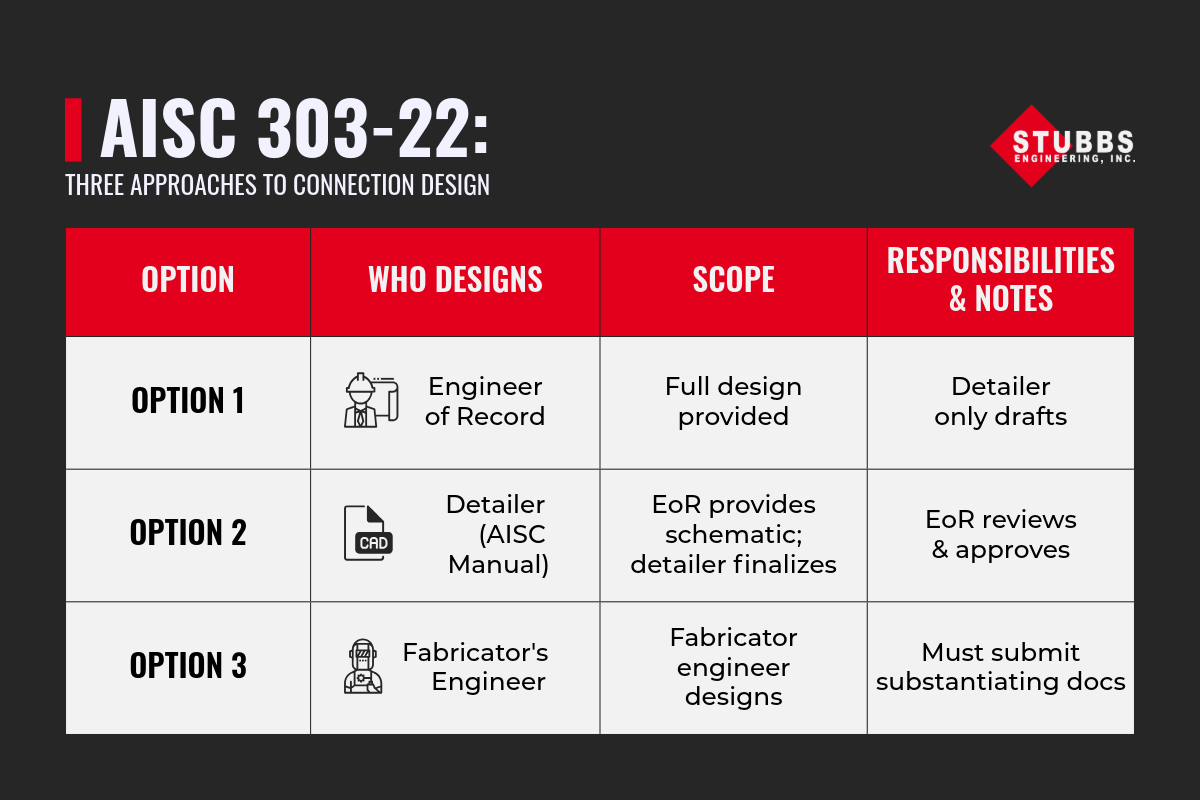
Introduction
In structural steel projects, efficiency isn’t just about speed—it’s about clarity.
For the design team and contractors navigating complex builds, delegated design can be a powerful tool to leverage the expertise of fabricators, erectors, detailers, and engineers who specialize in steel connection design. At its core, delegated design is the practice of allowing certain structural elements—like steel connections or miscellaneous components—to be designed by a qualified engineer within the scope of the steel fabricator.
When applied effectively, delegated design aligns overall design intent, fabricator-specific preferences, and construction timelines—delivering structures more efficiently. But without the right strategies in place, it can quickly become a source of confusion, rework, and delay.
This article explores delegated design through the lens of both practice and policy:
- What the AISC Code of Standard Practice says about delegated design
- The pros and cons of different connection design options
- Six field-tested strategies that can make or break a project
What Is Delegated Design—and Why It Matters
While the concept may sound straightforward, the execution of delegated design varies widely depending on project scope, team structure, and contractual expectations. The key is knowing how—and when—to delegate specific elements—like steel connections or miscellaneous components—to the appropriate party.
Why it matters:
- Faster project schedules ⏱
- Lower construction costs 💰
- Smarter use of expertise across the team 🤝
But it only works when roles, scope, and expectations are clearly defined. That’s where the AISC Code provides essential guidance.
📘 AISC 303-22: Three Approaches to Connection Design
According to Section 3.2.3 of the AISC Code of Standard Practice, there are three recognized options for who takes responsibility for steel connection design:

Option 1:
EoR Fully Designs the Connections
The Engineer of Record provides all necessary design details. The detailer’s job is to translate this into shop drawings—no design interpretation required.
Option 2:
Detailer Completes the Design with AISC Tables
The EoR supplies schematic-level details, and the qualified steel detailer completes the connection design using tables and guidance from the AISC Steel Construction Manual and the construction documents (with EoR approval).
Option 3:
Fabricator's Licensed Engineer Designs the Connections
A licensed engineer employed by the fabricator creates the design and submits substantiating documents for EoR review and approval.
💡 Each path impacts liability, schedule, and collaboration—so alignment on the right approach must happen early in the project.
Delegation Doesn’t Remove Responsibility
Even when design elements are delegated, the Engineer of Record (EoR) retains ultimate accountability for structural integrity—though effective coordination still relies on collaboration across the full team.
The AISC commentary reinforces that:
- The EoR retains ultimate responsibility for structural integrity
- Stamping shop drawings is discouraged
- Load cases and design criteria must be explicitly defined
When delegated design is part of the project, the EoR is inviting the connection engineer into the design process.
Clear communication and collaboration between both parties is the best way to ensure an efficient outcome.
Each side should be ready to openly discuss design criteria, constraints, and connection options.
The best results happen when both engineers are working together toward a shared solution.
Six Strategies to Make Delegated Design Work
Based on our real project experience, here are six key strategies we recommend:
1. Make it collaborative – Involve detailers, connection engineers and fabricators early in the process.
2. Share realistic reactions – Avoid generic or overly conservative values, like UDL tables from the AISC manual. When possible, provide actual calculated reactions.
3. Make the project bid-friendly – Include enough schematic details in the construction documents to guide connection intent. Flag any special conditions early so fabricators and connection eInclude enough schematic details in the construction documents to guide connection intent.
4. Provide substantiating documents – The EoR should set clear expectations for what’s required, and the connection engineer should communicate their design as clearly and completely as possible.
5. Define Design Criteria – The EoR should ensure that construction documents include accurate reactions, show any connection limitations, and clearly define expectations for submittals.
6. Manage architectural expectations – The EoR should assist the architect with the design of delegated elements—especially schematic input on monumental stairs and detailing for AESS members. Ensuring expectations are realistic before bidding helps avoid delays when aesthetic concerns surface during the shop drawing phase.
💬 These strategies aren’t just good practice—they can be the difference between a smooth submittal cycle and weeks of back-and-forth.
Conclusion
Delegated design isn’t about cutting corners—it’s about aligning teams strategically. When used thoughtfully and in line with the AISC Code of Standard Practice, it unlocks faster timelines, cleaner bids, and more effective collaboration between engineers, fabricators, and architects.
🔗 Want to dive deeper? We’re preparing a downloadable Delegated Design Resource Kit, including the full slide deck from Michael Stubbs’ 2024 NASCC talk.
📬 Launching Soon. Follow us on LinkedIn or subscribe to our newsletter to get early access.
other articles

We’re celebrating 15 years of engineering excellence, collaboration, and growth. This milestone wouldn’t be possible without our incredible clients and dedicated team who’ve shaped our journey from day one. Read more as we reflect on our achievements and look toward the next chapter.

This article breaks down how the AISC Code of Standard Practice (CoSP) clarifies the roles of the Engineer of Record, Steel Detailer, and Connection Engineer in connection design. It outlines the three primary design options, explains key provisions that ensure clarity and accountability, and highlights how consistent communication leads to safer, more efficient projects.

Learn how Seismic Design Categories (SDCs) affect every stage of a project, from design to construction and cost. This article explains the key factors that define your SDC and how early planning with your structural engineer can prevent costly redesigns and keep your project on schedule.
